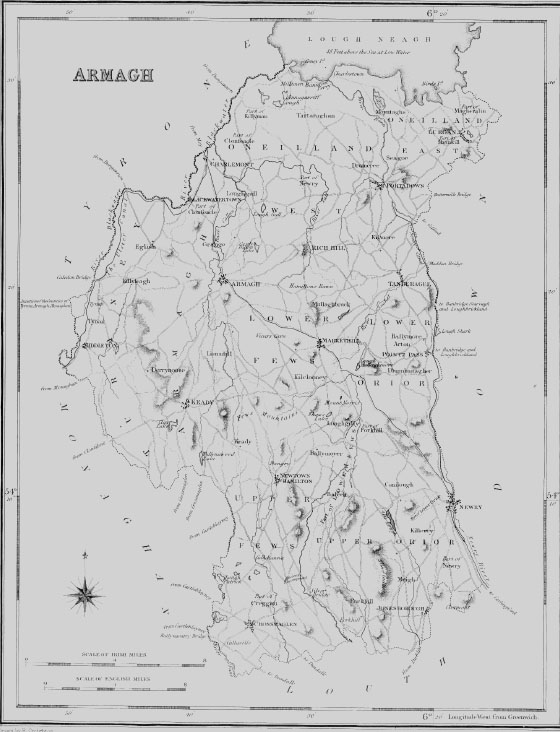| Accompanying Lewis map for Armagh 
|
| ARMAGH (Part 1) |
| ARMAGH, a city, market and post-town. and a parish, partly in the barony of O'NEILLAND WEST, but chiefly in that of ARMAGH, county of ARMAGH (of which it is the capital),and province of ULSTER, 31 miles (S. W. by W.) from Belfast and 653/4 (N.N.W.) from Dublin; containing 10,518 inhabitants, of which number, 9470 are within the limits of the borough. |
| ARMAGH (Part 2) |
| At the commencement of the Reformation, Primate Cromer was inflexible in his determination to oppose its introduction into the Irish church; and on his death, in 1542, his example was followed by his successor, Dowdall, who, after the accession of Edw. VI., maintained a controversy on the disputed points with Staples, Bishop of Meath, in which both parties claimed the victory. The English government, finding him determined in his opposition to the new arrangements, issued a mandate rendering his see subordinate to that of Dublin, which caused Dowdall to quit the country and take refuge on the continent. The king, deeming this act a virtual resignation of the see, appointed Hugh Goodacre his successor; but Dowdall was restored by Queen Mary, and held the see till his death in 1558, the year in which his protectress also died. Notwithstanding the ecclesiastical superiority of the see of Armagh over that of Dublin, the income of the latter was so much greater, that Adam Loftus, who had been appointed Archbishop of Armagh on the death of Dowdall, was removed a few years after to Dublin, as being more lucrative: he was only 28 years of age on his first elevation, being the youngest primate of all Ireland upon record, except Celsus. In 1614-15, a regrant of the episcopal property of Armagh, together with a large additional tract of land, accruing from the forfeited estates of the Earls of Tyrone and Tyrconnel, was made to Primate Hampton. His immediate successor was the celebrated James Ussher, during whose primacy Chas. I. endowed anew the college of vicars choral in the cathedral, by patent granted in 1635, by which he bestowed on them various tracts of land, the property of the dissolved Culdean priory. Ussher was succeeded by Dr. Bramhall, a man also of great learning and mental powers, who was appointed by Chas. II. immediately after the Restoration. Dr. Lindsay, who was enthroned in 1713, endowed the vicars choral and singing boys with £200 per annum out of lands in the county of Down, and also procured for them a new charter, in 1720. Dr. Boulter, who was translated from the see of Bristol to that of Armagh, on the death of Lindsay in 1724, is known only as a political character; a collection of his letters is extant. He was succeeded by Dr. Hoadly, translated from Dublin, who published some sermons and other works; and the latter by Dr. Stone, also an active participator in the political events of the time. His successor was Dr. Robinson, Bishop of Kildare, and after his translation created Baron Rokeby, of Armagh, whose history may be best learned in the contemplation of the city over which he presided, raised by his continued munificence from extreme decay to a state of opulence and respectability, and embellished with various useful public institutions, worthy of its position among the principal cities of Ireland; and from the pastoral care evinced by him in an eminent degree in the erection of numerous parochial and district churches for new parishes and incumbencies, to which he annexed glebes and glebe-houses, and in promoting the spiritual concerns of his diocese. |
| KILLYLEAGH |
| KILLYLEAGH, a district parish, partly in the barony of TURANEY, and partly in that of ARMAGH, county of ARMAGH, and province of ULSTER, 5 miles (W.) from Armagh, on the road from that place to Caledon ; containing 3452 inhabitants. It was formed out of the parishes of Armagh, Tynan, and Derrynoose, under the provisions of the act of the 8th of Geo. IV., cap. 43 ; and comprises 5635 statute acres of very fertile arable and pasture land, which is under an excellent system of cultivation. A great part of the parish and the whole of the village belong to Trinity College, Dublin. Here are some excellent quarries of freestone, clay-slate, and limestone, of which the last is extensively worked: coal also exists on the College estate, but is not much used. Linen-weaving is carried on to a considerable extent. The village, which is on the side of a hill near the Ulster Canal, consists of one long street of stone houses: it has a penny post to Armagh and Tynan, and a cattle fair on the last Friday in every month. A court for the manor of Toaghey and Balteagh is held monthly, for the recovery of debts under 40s. The principal seats in the parish are Elm Park, the residence of the Earl of Charlemont, which is in a beautifully planted demesne ; Knappagh, of 3. Johnston, Esq. ; Woodpark, of A. St. George, Esq. ; Fellows-hall, of T. K. Armstrong, Esq. ; and Dartan, of Maxwell Cross, Esq. The living is a perpetual curacy, in the diocese of Armagh, and in the alternate patronage of the rectors of Armagh, Derrynoose, and Tynan, each of whom contributes to the perpetual curate's stipend. The church, which was erected by subscription in 1832, is a handsome building, with a lofty square tower, on an eminence. About 210 children are educated in the parochial and another public school, the latter of which is aided by an annual donation from - Close, Esq. ; and about 140 in two private schools. |
|